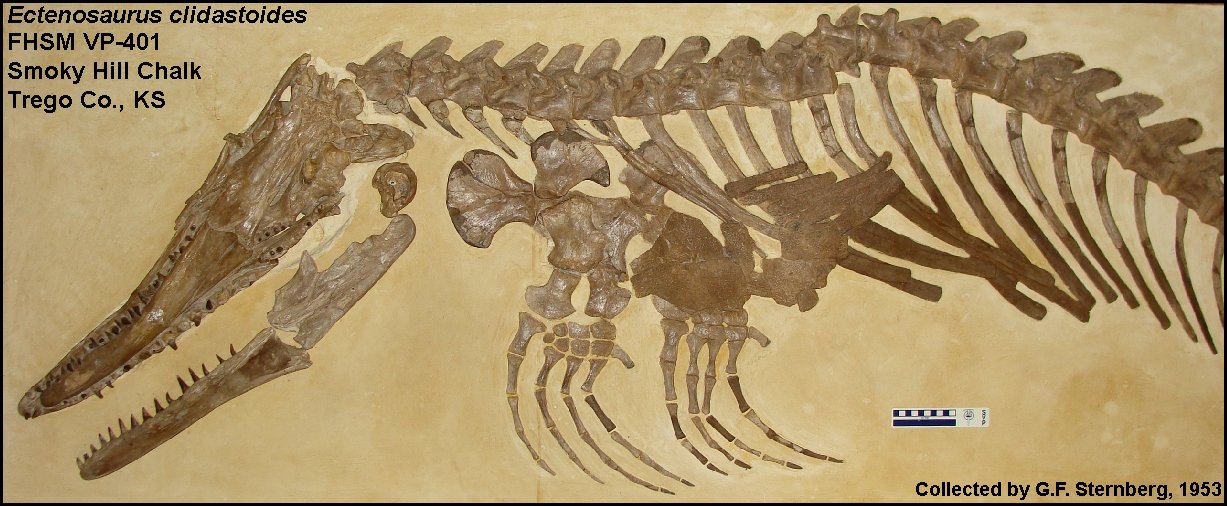
Ectenosaurus clidastoides
FHSM VP-401
A unique Kansas mosasaur with preserved skin
Copyright ©2011 by Mike Everhart
Page created 11/14/2011- Last updated 11/21/2011
 |
Ectenosaurus clidastoides FHSM VP-401 A unique Kansas mosasaur with preserved skin
Copyright ©2011 by Mike Everhart
Page created 11/14/2011- Last updated 11/21/2011
|
Ectenosaurus clidastoides is a relatively rare mosasaur, currently known only from the Smoky Hill Chalk of western Kansas, USA. The species was initially described as Platecarpus clidastoides by Merriam (1894) from a specimen collected by C.H. Sternberg or G. Bauer from Logan County, Kansas. The type specimen was in the Bayerische Staatssammlung fur Palaontologie, but the specimen was probably destroyed in World War II:
| "P. clidastoides nov. spec. Die Aufstellung dieser Species stützt sich auf ein Parietale, das ganze Hinterhaupt, das Quadratojugale, den Atlas, einige Dorsal- und 3 Caudalwirbel. Sie characterisirt sich durch das eigenthfimliche Parietale, das varn ein niedriges dreieckiges Feld zeigt, in dessen Mitte das verhtiltnissmassig kleine, runde, von der Coronalsutur weit entfernte Scheitelloch liegt. Am Hinterende ist das Scbeitelbein vertical verflacht und zeigt grosse Aehnlichkeit mit dem von Olidastes. Das ganze Aussehen dieses Knochens ist durchaus verschieden vondem der anderen Platecarpus-Species. Die Zugehörigkeit zu dieser Gattung wird jedoch durch das durchbohrte Basioccipitale und das Platecarpus-ähnliche Seitenstück des Atlas bewiesen. Die Wirbel sind so zerquetscht und verwittert, dass sie weder als Platecarpus- noch Clidastes-ähnlich zu erkennen sind." (From Merriam, 1894, p. 30) |
In 1953, George Sternberg discovered a much better specimen (GFS 109-53) about 9 miles north of WaKeeney, Kansas. The mosasaur was about 9 feet in length, mostly articulated, but had previously lost the rear limbs and tail to erosion. Sternberg initially identified it in his field notes as Clidastes velox. His notes on the specimen are shown below:
|
CLIDASTES VELOX
Museum
No. 7937
VP-401
The tail and hind limbs had been eroded away before it was
discovered.
The skull is mounted upside down showing the exact position it
was in when found. It is removable and can be turned over so as to study
the top of the head. All teeth are shown and the small teeth attached to
the pterygoids, ten in number. There [are] seventeen or eighteen tooth
sockets in the upper jaws. The distal end of the right lower dentary has
been restored.
There are twenty-nine continuous vertebrae present. The front
paddles are quite complete. A number of cartilaginous ribs are present
also a large section of the cartilaginous breast bone.
The ribs share were complete when found but the lower ends of a
number of them were so badly eaten with a low grade of iron that they
had to be restored.
All of the original matrix has been removed and the specimen is
mounted on a plaster base. |
The mounted specimen was on exhibit in Sternberg Memorial Museum on the campus of Fort Hays State University from the mid-1950s to 1999 when the museum was closed in preparation to move to the current location. Currently the specimen is in storage. It was examined in 1963 by Dale Russell, then of the American Museum of Natural History, and determined to be Platecarpus clidastoides instead of Clidastes velox. In a letter from Dale Russell to Myrl Walker, he indicated that it represented the only specimen of a rare mosasaur species, and that he would rename it as Ectenosaurus clidastoides in a future publication. Russell published his Systematics and Morphology of American Mosasaurs in 1967, and Ectenosaurus clidastoides (new genus) is officially re-described and named on page 156. The front limb and the skull in dorsal view were included as Text-figs. 54 and 86. Aside from Russell's (1967) description, nothing else has been published on this specimen other than Bell 1997, and mentions by Everhart 2000, 2005. A second specimen (FHSM VP-13746) was reported by Everhart (2004) from shark scavenged remains discovered in Gove County. Everhart (2005, fig. 9.5) published photos of the skull. The preservation of scales associated with this specimen was mentioned in a Masters thesis by Schumacher (1993) and further discussed in an unpublished thesis by Valerio (2008).
In George Sternberg's 1953 note on the FHSM VP-401 specimen, there is an
interesting statement: "These small section[s]
of chalk rock show the fine scale impressions from a Cretaceous mosasaur,
specimen #7937.
All of these specimens were collected from the Smoky Hill Chalk. Subsequently, Lindgren, et al. (2009) reported scale impressions from a specimen of Plotosaurus in California, and Lindgren, et al. (2010) described scale impressions preserved in association with a Platecarpus specimen (LACM 128319) from western Kansas. The LACM 128319 scale impressions were first reported by Geist et al. 2002.
Also, in August-October, 1951, G.F. Sternberg collected a fairly complete, 20 foot long Tylosaurus specimen (GFS 1-51; FHSM VP-327), including a 35 inch skull, from a roadside exposure along Highway 24 west of Hill City (Graham County) that included scale impressions in the abdominal region. The specimen was subsequently sent to the Los Angeles County Museum in an exchange, and has not been relocated. All that remains in the records are three color photographs, two of which show the collected specimen (vertebrae, ribs and scale impressions) and the other which shows the locality. Sternberg's field notes indicated that the scales were fragile and might not be able to be saved.
The latest report on mosasaur integument comes back to the FHSM VP-401 specimen. On November 16, 2011, we reported not only the scale impressions of Ectenosaurus clidastoides (FHSM VP-401), but the three-dimensional, layered structure of the skin:
|
Lindgren, J., Everhart, M.J. and Caldwell, M.W. 2011. Three-dimensionally preserved integument reveals hydrodynamic adaptations in the extinct marine lizard Ectenosaurus (Reptilia, Mosasauridae). PLoS One. Abstract: The
physical properties of water and the environment it presents to its
inhabitants provide stringent constraints and selection pressures
affecting aquatic adaptation and evolution. Mosasaurs (a group of
secondarily aquatic reptiles that occupied a broad array of predatory
niches in the Cretaceous marine ecosystems about 98–65 million years
ago) have traditionally been considered as anguilliform locomotors
capable only of generating short bursts of speed during brief ambush
pursuits. Here we report on an exceptionally preserved, long-snouted
mosasaur (Ectenosaurus clidastoides) from the Santonian (Upper
Cretaceous) part of the Smoky Hill Chalk Member of the Niobrara
Formation in western Kansas, USA, that contains phosphatized remains of
the integument displaying both depth and structure. The small, ovoid
neck and/or anterior trunk scales exhibit a longitudinal central keel,
and are obliquely arrayed into an alternating pattern where neighboring
scales overlap one another. Supportive sculpturing in the form of two
parallel, longitudinal ridges on the inner scale surface and a complex
system of multiple, superimposed layers of straight, cross-woven helical
fiber bundles in the underlying dermis, may have served to strengthen
the skin, thereby minimizing surface deformation and frictional drag
during locomotion. Additional parallel fiber bundles oriented at acute
angles to the long axis of the animal presumably provided stiffness in
the lateral plane. These features are consistent with advanced
hydrodynamic adaptations of fast swimming fishes, such as tuna and
sharks, and of ichthyosaur reptiles, and thus suggest that mosasaurs
were efficient swimmers. These features suggest that the anterior torso
of Ectenosaurus was held somewhat rigid, whereas motion was restricted to the posterior body and tail; i.e., a sub-carangiform
mode of swimming. |
The photographs below show various aspects of the FHSM VP-401 specimen not previously published.
 |
LEFT: The skull of the Ectenosaurus clidastoides
(FHSM VP-401) specimen in right dorso-lateral view.
RIGHT: The skull of the Ectenosaurus clidastoides (FHSM VP-401) specimen in ventral view, including the left lower jaw in lateral view. |
 |
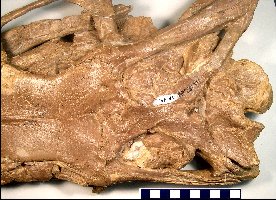 |
LEFT: The frontal-parietal bones, including the parietal
foramen, of the Ectenosaurus clidastoides (FHSM VP-401) skull in
dorsal view.
RIGHT: The orbit of the right eye of the Ectenosaurus clidastoides (FHSM VP-401) skull in lateral view, including the postorbital frontal, frontal, prefrontal and jugal. |
 |
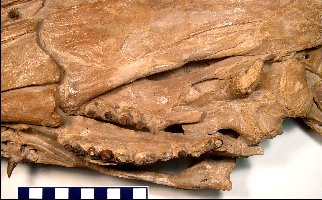 |
LEFT: The paired pterygoid bones of the Ectenosaurus
clidastoides (FHSM VP-401) skull, partially exposed under the left
lower jaw.
RIGHT: The posterior corner of the Ectenosaurus clidastoides (FHSM VP-401) skull in right lateral view, including the squamosal, postorbital frontal and posterior portion of the jugal. |
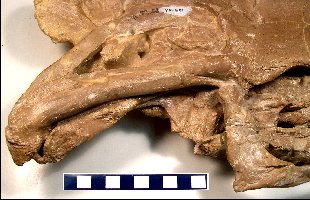 |
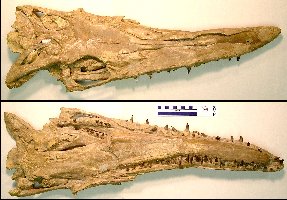 |
LEFT: Dorsal and ventral views of the Ectenosaurus
clidastoides (FHSM VP-401) skull. See
labeled drawing from Russell (1967) here. RIGHT: Lateral and medial views of the right quadrate of the Ectenosaurus clidastoides (FHSM VP-401) skull. |
 |
 |
LEFT: A detail view of several teeth on the right maxilla
of the Ectenosaurus clidastoides (FHSM VP-401) skull. RIGHT:
A detail medial view of a complete tooth in the right maxilla, showing bud
teeth forming in the medial side of the maxilla. The teeth are described
by Russell (1967, p. 156) as "bicarinate, vertically striated and
medially recurved." |
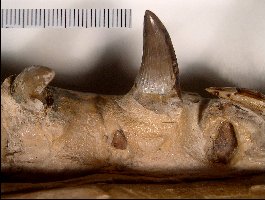 |
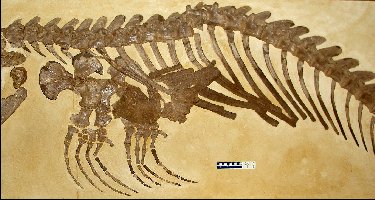 |
LEFT: The post-cranial skeleton of FHSM VP-401. The rear
limbs and tail were lost to erosion prior to discovery by G. F. Sternberg RIGHT: Preserved cartilage of the sternal ribs and sternum of FHSM VP-401. |
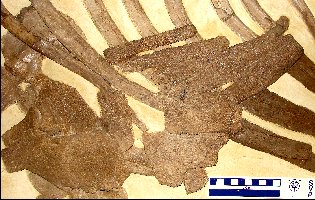 |
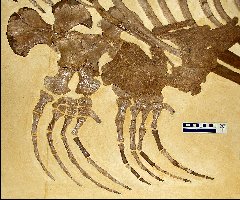 |
LEFT: The well preserved front limbs of the FHSM VP-401
specimen. The fifth digit is apparently greatly reduced in Ectenosaurus
clidastoides. RIGHT: A close-up photo of the left front paddle of FHSM VP-401. See labeled drawing from Russell (1967) here. |
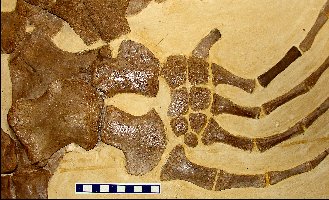 |
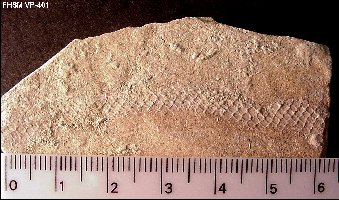 |
The following four close-up photos were taken in 2005 when I
became interested in what I thought were "just skin impressions"
(Everhart 2005).
LEFT: A series of scale impressions in the matrix from the FHSM VP-401 Ectenosaurus clidastoides specimen. A note included with the specimen said that the impressions were discovered in the neck region of the specimen (between the lower jaws and the front limbs). RIGHT: Two more small fragments of the matrix with scale impressions. The scales measure about 2.7 mm in length by 2 mm in width, and where preserved, they are about 0.1 mm thick. |
 |
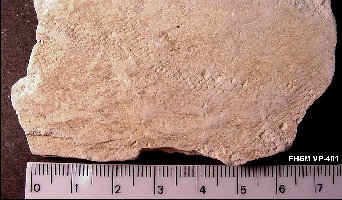 |
LEFT: Another fragment of the matrix with scale
impressions. Initially I had reported (Everhart 2005) that the scale
impressions did not show a central keel, but upon closer examination it
became evident that they do have a keel similar to
those found in Tylosaurus
(KUVP 1075). RIGHT: Another fragment of the matrix with scale impressions. This piece, however, does show some of the three-dimensionality of the preserved skin layers, including some of the associated fibrous structures. After the 2nd Mosasaur Meeting in May, 2007, Johan Lindgren and I started talking about the skin preservation in the Ectenosaurus specimen. That conversation continued during a September 2010 meeting at the University of Kansas when we examined the KUVP 1001 Platecarpus specimen for skin impressions. In the meantime, Lindgren and others (2009, 2010) had published papers regarding the discovery of scales in Plotosaurus and Platecarpus. |
 |
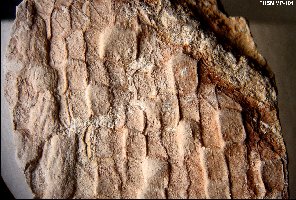 |
In 2010, Johan and I began to look more critically at the
FHSM VP-401 matrix fragments. As might be expected, the more we looked,
the more structure we found. The following six photos, taken through
a binocular microscope and using a single light source, are examples of
preserved scales, scale impressions, and underlying integument preserved
in the matrix surrounding the bones of FHSM VP-401.
LEFT: This fragment preserves what appears to be the underside of the scales. RIGHT: Another fragment showing the underside of a group of scales, but also demonstrating layers of structure in the preservation. |
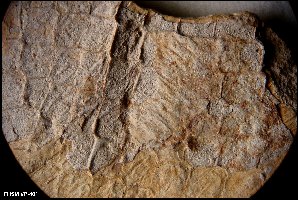 |
 |
LEFT: This piece shows what appears to be the mid-line
between two groups of scales, trending from lower left to upper right. as
well as layers of structures.
RIGHT: Another fragment showing the underside of a group of scales, but also demonstrating the layering of structures in the preservation. |
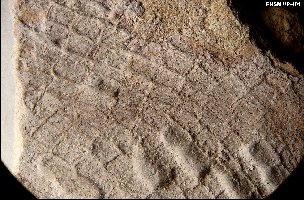 |
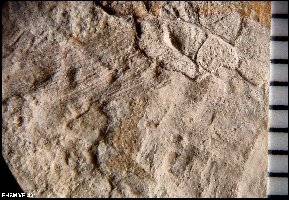 |
LEFT: Another instance showing the underside of the
scales, including layering, and in addition, a patch of phosphatized
tissue (fiber bundles) on the left side of the photo. RIGHT: This specimen preserves a patch of scales, showing the central keels in some areas, plus layering and soft tissue remains. Additional photos at higher resolution and using scanning electron microscope (SEM) technology are included in our publication published on November 16, 2011 in PLoS ONE. |
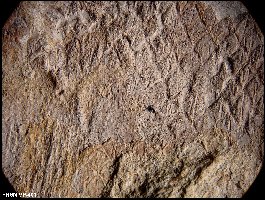 |
REFERENCES:
Bell, G.L. Jr. 1993. A phylogenetic revision of Mosasauroidea, unpublished Ph.D. dissertation, The University of Texas at Austin, 293 pp.
Bell, G.L. Jr. 1997. A phylogenetic revision of North American and Adriatic
Mosasauroidea. pp. 293-332 in Callaway J. M.
and E. L Nicholls, (eds.), Ancient Marine Reptiles, Academic Press, 501 pages.
Cope, E.D. 1875. The Vertebrata of the Cretaceous formations of the West. Report, U. S. Geological Survey Territories (Hayden). 2:302 p, 57 pls.
Everhart, M.J. 2001. Revisions to the Biostratigraphy of the Mosasauridae (Squamata) in the Smoky Hill Chalk Member of the Niobrara Chalk (Late Cretaceous) of Kansas. Kansas Academy Science, Transactions 104(1-2):56-75.
Everhart, M.J. 2002. New data on cranial measurements and body length of the mosasaur, Tylosaurus nepaeolicus (Squamata; Mosasauridae), from the Niobrara Formation of western Kansas. Kansas Academy of Science, Transactions 105(1-2):33-43.
Everhart, M.J. 2004. Late Cretaceous interaction between predators and prey. Evidence of feeding by two species of shark on a mosasaur. PalArch, vertebrate palaeontology series 1(1):1-7.
Everhart, M.J. 2005. Oceans of Kansas - A Natural History of the Western Interior Sea. Indiana University Press, 322 pp.
Geist, N.R., Carpenter, S., and Stewart, J.D. 2002. Chemical and morphological analysis of soft tissue preservation in a mosasaur. Journal of Vertebrate Paleontology 22(Supplement to 3):57A.
Lane, H. H. 1946. A survey of the fossil vertebrates of Kansas, Part III, The Reptiles, Kansas Academy Science, Transactions 49(3):289-332, 7 figs.
Lindgren, J.,
Lindgren, J., Alwmark, C., Caldwell, M.W. and Fiorillo, A.R. 2009. Skin of the Cretaceous mosasaur Plotosaurus: implications for aquatic adaptations in giant marine reptiles. The Royal Society, Biological Letters, published online 8 April 2009.
Lindgren, J., Caldwell, M.W., Konishi, T. and Chiappe, L.M. 2010. Convergent evolution in aquatic tetrapods: insights from an exceptional fossil mosasaur. PLoS ONE.
Lindgren, J., Everhart, M.J. and Caldwell, M.W. 2011. Three-dimensionally preserved integument reveals hydrodynamic adaptations in the extinct marine lizard Ectenosaurus (Reptilia, Mosasauridae). PLoS ONE.
Merriam, J.C. 1894. Ueber die Pythonomorphen der Kansas-Kreide. Palaeontographica, 41:1- 39, 4 pls. (in German)
Polcyn, M.J. and Everhart, M.J. 2008. Description and phylogenetic analysis of a new species of Selmasaurus (Mosasauridae: Plioplatecarpinae) from the Niobrara Chalk of western Kansas. pp. 13-28 in Everhart, M.J. (ed.), Proceedings of the Second Mosasaur Meeting, Fort Hays Studies Special Issue 3, Fort Hays State University, Hays, Kansas.
Russell, D.A. 1967. Systematics and morphology of American mosasaurs. Peabody Museum of Natural History, Yale University, Bulletin 23.
Schumacher, B.A. 1993. Biostratigraphy of Mosasauridae (Squamata, Varanoidea) from the Smoky Hill Chalk Member, Niobrara Chalk (Upper Cretaceous) of Western Kansas, Unpub. Masters Thesis, Fort Hays State University, 68 pp.
Snow, F.H. 1878a. On the dermal covering of a mosasauroid reptile. Kansas Academy of Science, Transactions 6:54-58, Fig. 1-2.
Snow, F.H. 1878b. On the dermal covering of a mosasauroid reptile (Liodon dyspelor Cope). Kansas City Review of Science and Industry. 2(8):451-454.
Snow, F.H. 1879. The scales of Liodon. American Naturalist 13(2):132.
Valerio, K. 2008. Anatomy, biostratigraphy, paleoecology, and systematics
of Ectenosaurus clidastoides
(Squamata, Mosasauridae). Unpublished Masters thesis,
Williston, S.W. 1898a. Editorial Notes. Kansas University Quarterly 7(4):235.
Williston, S.W. 1898b. Mosasaurs. The University Geological Survey of Kansas, Part V. 4:81-347, pls. 10-72.